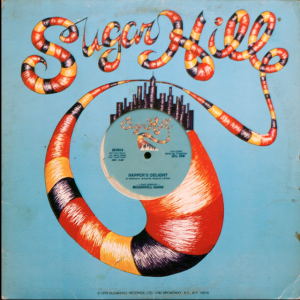
You can’t have a conversation about Hip-Hop without mentioning The Sugarhill Gang.
Forming in Englewood, New Jersey back in August 1979, The Sugarhill Gang is named after their neighborhood in Harlem named Sugar Hill. Originally composed of members Michael “Wonder Mike” Wright, Henry “Big Bank Hank” Jackson, and Guy “Master Gee” O’Brien,” no one could predict the impact and influence of their breakout hit “Rapper’s Delight,” which served as the first rap single to chart as a Top 40 hit on the Billboard Hot 100.
The beauty lies in the fact that 45 years later, the group is able to still tour the timeless record today. Most recently, The Sugarhill Gang performed an intimate performance with Live At The Print Shop, celebrating their contributions to the genre of Hip-Hop as a whole. Their set was paired with a meaningful sit-down interview as they reflect on their history and legacy in the music industry.
The Source spoke with the current members — Master Gee, DJ T-Dynasty, Wonder Mike, and Hen Dogg — via Zoom to discuss what the moment they fell in love with Hip-Hop, the influence of “Rapper’s Delight,” how they view Hip-Hop today, and more!
What was the moment you guys fell in love with Hip-Hop?
T-Dynasty: When I fell in love with Sugarhill Gang. That’s when I fell in love with Hip-Hop. When I fell in love with the people, not the music. Understand me, and Mike knows I’m not telling no lies. Mike, I want you to explain it because there was Hip-Hop for him to fall in love with.
Wonder Mike: Yeah, we’d go and get big ass submarine sandwiches, eat it and smoke. I was the first voice globally. Sugarhill Gang was the first group globally. “Rapper’s Delight” was the first song globally, and my voice started out the record. You can see some of the things on TV and in movies, I wonder when was the first time they used color film? What was the first time they used stereo in music? Who was the first voice of Hip-Hop? Those things are impossible to trace, but this isn’t. You’re speaking through the soul that awoke the world for Hip-Hop.
I was just a little brother in Newark, New Jersey. Newark, New Jersey is like Harlem, the Bronx and Brooklyn all in one. With the good points, not the bad. The good points – cultural diversity. My god, to come up and do this? 44 years later? We’re still here, people call us to do shows..
Hen Dogg: No doubt, it’s a beautiful thing.
Wonder Mike: We sound like gentlemen. We ain’t wilding out, we don’t disrespect women. That’s not us. That’s not our style.
I interviewed so many artists that when I asked them the moment they fell in love with Hip-Hop, they said Sugarhill Gang “Rapper’s Delight.” How does that make you feel?
Wonder Mike: It’s great because I fell in love with Hip-Hop with a group called Sound On Sound. My cousin Mark was an MC in the group, Daddy Right. They had 15 guys in the group! When he first came down the street, Green Avenue with a big boombox. The biggest radio set I’ve ever saw. He said “Yo cuz, check this out.”
Some guy was on there, it wasn’t him or any of his boys. They were going “[raps].” I said what is that? He said, “This a new thing. It’s Hip-Hop.” I said it sucks! Because it was a bad representation of what it was. He invited me to one of their shows, and I saw how it’s supposed to be done. [raps] Oh, this is fire. I find myself making up rhymes on my job. I said yo, let me join the group. I joined May 28th 1979, and we recorded “Rapper’s Delight” in August 1979. That’s how fast my career took off.
How did your guys’ lives change after “Rapper’s Delight”? Just given how much the song has influenced the game.
Wonder Mike: When I was seven years old and saw the movie A Hard Day’s Night. These guys are singing these really catchy songs on the screen, girls are screaming, losing their minds and chasing them. And that’s what happened to us. We couldn’t even finish the first few shows, the first months because they would go on the stage. Pass the bodyguard, tried to take our clothes off. Thank God, I had to run out of how many back doors. Down the alley. Hank was big and he couldn’t move as fast as us. Or at least that’s what he told y’all.
T-Dynasty: [laughs] Right.
Wonder Mike: God, that noise of screaming girls. I knew that noise when we’re running down the alley. We’d see them, oh my God. We had run around the other way. This is Europe. We jumped in a Fiat cab. By that time, Hank had gotten out through the streets. We got in that cab and closed the door. Those girls were rocking back and forth, we got on two wheels. The cab driver says, “Get them off of my cab!”
45 years later, how does it feel to still perform the record?
Hen Dogg: Great, beautiful. It never gets old.
T-Dynasty: Never. In all the performances that have happened, a lot of people always ask that question. “What does it still do?” Or “what does it do for you?” After 28 years, it’s still magical for me. For 43 years, I know it’s magical for Mike because he gets the smile on his face every damn time. We could be feeling the worst: legs falling off, everything’s falling apart. But when we hit that stage, whatever time we gon’ be there — whether it’s 30 minutes or three hours, it’s all showtime. It’s all fun. When we get off the stage, we’re so happy. We’re elated. You’re happy and you’re ready to go on to the next thing.
Hen Dogg: Absolutely. 100% correct. I feel the same way. Like Bruce Springsteen, I watched him on 60 Minutes one evening. They were interviewing, talking about all his success and all that. Finally the question was put to him. They said, “Bruce, you’re a millionaire 10 times over. Why do you still go out and perform?” Bruce said, “Because there’s no better high in the world than to be on stage. performing in front of thousands of people. And all that energy is focused on you.” It hits you, there’s no better feeling in the world than that. None. There’s no drug you can give me, no drink. Nothing, there’s no better feeling in the world.
Wonder Mike: And the money only helps just little bit.
All: [laughs]
Wonder Mike: I still get a rush out of going on stage. People say “don’t you get tired of it?” No. I don’t get tired of flying to Europe on other people’s dimes. I don’t get tired of going to the Eiffel Tower during the day, that other people are paying for. Then doing the show, getting paid for that? I don’t get tired of that,
Hen Dogg: Nope! My grandmother always says that if you can make a living doing something that you love to do, then you’ll never work a day in your life.
T Dynasty: I like that. We work harder getting to the show, than the actual show. A lot of people don’t know that. They only see the glitz, the glamour. The pictures when you got your champagne on the stage. But you gotta get up at 2:30am to make it to this airport, stand in this line to get to here. We have our days when you know everybody’s not feeling less than perfect, you have those situations to still go through. When you hit that stage, nobody cares about anything else but I spent my money. I came here to fulfill my dream or to see somebody I love. They don’t want to hear no excuse, they just want to see that person. They want to hear that song, make them feel a way.
Hen Dogg: Exactly.
T Dynasty: Especially if the record is that big, and the people are still around to perform it. All you gotta do is get a ticket. I’m looking at a Steve Perry video, the lead singer for Journey. I didn’t know Journey was around for 10 years and that’s it, it seems like forever. The Beatles were in their heyday for 5.5 years, from ‘64 to February 1970. And that was it. We’re here 44 years. Some of our audience members were six years old. The parents went out to Sears and they told the babysitter “make sure he’s in bed at a certain time,” now they’re at the show. A gentleman in Scotland told us he brought his grandchild to the show.
[Master Gee enters the Zoom]
Perfect timing, how was it performing Live At The Print Shop? And what that meant to celebrate in that light.
Master Gee: That was a really good show for us. That was really nice. It was good to have everybody in the same space, get that kind of time to talk about everything we’re doing. Everything we’ve been through, it’s very good. I really enjoyed it. Based on what I hear, the feedback has been phenomenal.
How do you guys view Hip-Hop today?
Master Gee: We view Hip-Hop today like Hip-Hop was viewed when we first started. The only difference is you can say more, you can get away with more. You can expose the public to more of the intimacies of it, but representation in Hip-Hop is exactly what it was when we first started doing it. I was in a conversation the other day where people were talking about the generation before us was Blue Magic, Ohio Players, etc. That generation was looking at our music saying “They’re just talking over the music. There’s no hook, there’s no melody.”
I was just in a conversation with Mad Skillz, he was talking about how the first time he heard “Rapper’s Delight.” He was six or seven years old and his parents were saying what I’m saying. “There’s no melody, there’s no hook. That’s not music.” What are people saying today? “There’s no content, there’s no story.” It’s the same thing!
Wonder Mike: Classical was around forever. Here comes Frank Sinatra, Dean Martin, and all these guys. That was like an abomination to music. Every genre when it starts out, people ahead say like, “nah, that shit is whack. That’s not real music.” Come on man.
Dynasty: They even said hardcore jazz musicians were devil’s music. When you really think about it, each genre had its own time to get where it had to go to. But I tell you what, this one isn’t going nowhere.
What’s up with the new Sugarhill Gang drill rappers [Sugarhill Ddot]? They got a lot of murder in their music.
Master Gee: My comment stays the same with it. The only reason why people are doing that drill rap and talking about whatever they’re talking about is because the public allows them to do it. That’s all it is, it’s sensationalist. Trust me, if they were trying to cut through and become successful artists, the paradigm shifted and said “no, you can’t talk about guns.” Guess what everybody’s gonna start doing? Not talk about guns. The only time it would be would be some abstract, “I’m for the underground,” blah blah blah. But you best believe somebody that’s out here trying to become successful doing this: if the code says no more talking about guns, knives and murder, that’s what’s gonna happen. To me, that’s sensationalist.
The post How The Sugarhill Gang’s Lives Changed After “Rapper’s Delight” first appeared on The Source.
The post How The Sugarhill Gang’s Lives Changed After “Rapper’s Delight” appeared first on The Source.



